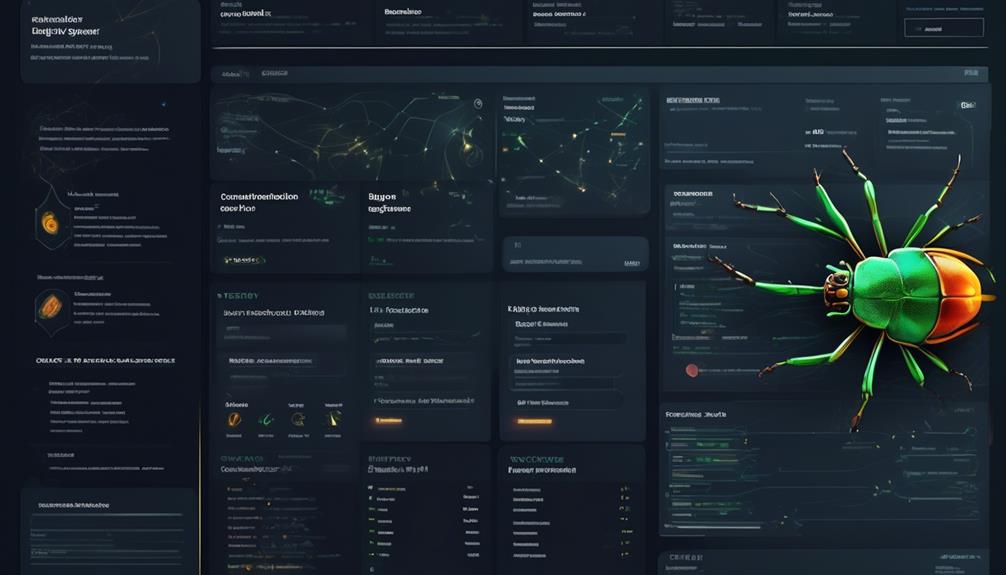As Quality Assurance engineers, we navigate the intricate realm of software testing using a range of tools that serve as dependable allies in our pursuit of excellence.
These tools are the silent partners that aid us in unraveling the mysteries of code, uncovering hidden bugs, and ensuring the seamless functioning of applications.
But are we truly harnessing the full potential of these tools? Are there untapped resources waiting to be discovered?
Join us as we explore the world of QA Engineer Tools and uncover the hidden gems that can elevate our testing capabilities to new heights.
Key Takeaways
- TestRail is a comprehensive test case management tool that tracks test progress and facilitates reporting.
- Disbug is a bug reporting and management tool that integrates with project management tools like Trello and Jira.
- Bug Tracking Systems improve communication among team members and integrate with project management tools.
- Test automation tools should be compatible with Continuous Integration systems, prioritize automated regression testing, and offer robust API testing capabilities.
- Performance testing software like JMeter and Gatling provide load testing and performance analysis capabilities, and integrate with project management tools.
- Reporting and Analytics Tools offer comprehensive analysis and visualization of data, metrics and reports to track testing progress, code quality analysis and management, and support continuous improvement.
Essential SDLC Tools
In our pursuit of efficient software development, we rely on a suite of essential SDLC tools that enable us to streamline testing processes, manage test data effectively, and ensure code quality analysis throughout the development lifecycle.
These tools are crucial for our QA and testing efforts. TestRail plays a pivotal role in our testing process by providing comprehensive test case management, tracking the progress of tests, and facilitating test reporting. Its ability to manage test data effectively ensures that our testing processes are organized and efficient.
Additionally, Disbug enhances our bug reporting process by providing visual feedback and seamless integration with project management tools like Trello and Jira. This integration streamlines bug tracking and management, allowing our team to focus on resolving issues efficiently.
Furthermore, SonarQube is instrumental in our QA testing, identifying problems early, providing code quality analysis and management, and assisting in finding solutions quickly.
These tools, in conjunction with our automation frameworks, contribute to the overall quality and efficiency of our software development.
Testing Automation Frameworks

Our pursuit of efficient software development through essential SDLC tools naturally leads us to embrace Testing Automation Frameworks as a means to enhance our testing processes with precision and methodical automation. When considering test automation tools, it's essential to evaluate their compatibility with Continuous Integration (CI) systems to ensure seamless integration into the development pipeline. Additionally, the ability to perform automated regression testing across different web browsers is crucial for comprehensive test coverage.
We prioritize the selection of test automation tools that offer robust support for API testing. This ensures that our software's backend functionality is thoroughly validated through automated testing processes.
By integrating automated API testing tools into our framework, we can streamline the identification and resolution of potential issues, enhancing the overall efficiency of our bug reporting process.
Performance testing capabilities are another key aspect we consider when evaluating testing automation frameworks. The ability to automate performance tests allows us to proactively identify and address potential bottlenecks in our applications, ensuring optimal performance throughout the software development life cycle.
Performance Testing Software
Performance Testing Software provides valuable insights for QA engineers through thorough testing and analysis of various systems, offering essential load testing and performance analysis capabilities. This software ensures efficient test management and integrates with project management tools like Trello or Jira, while also automatically capturing technical logs. Two prominent examples of performance testing software are JMeter and Gatling. JMeter is a versatile Java application that focuses on load testing and performance analysis for web applications and e-commerce systems. On the other hand, Gatling serves as a project management tool, aiding in tracking tests, automatic test execution, bug tracking, and task prioritization for efficient test management for QA engineers. Both tools are essential for ensuring code quality, comprehensive test coverage, and continuous delivery in software development. They play a crucial role in the overall software testing ecosystem, complementing other QA engineer tools and test automation frameworks. The table below summarizes the essential features of these performance testing software tools.
| Software | Key Features |
|---|---|
| JMeter | Load testing, performance analysis for web applications and e-commerce systems |
| Gatling | Test tracking, automatic test execution, bug tracking, and task prioritization for efficient test management |
Bug Tracking Systems

Bug Tracking Systems play a pivotal role in recording, managing, and tracking the progress of identified software bugs, seamlessly integrating with project management tools for efficient coordination between bug tracking and project tasks. When considering bug tracking systems, it's essential to delve into the specific features and capabilities that these tools offer:
- Bug Management: Bug Tracking Systems provide a centralized platform for teams to report, prioritize, assign, and resolve issues throughout the software development lifecycle. This aids in improving communication among team members and enables efficient bug resolution.
- Integration with Project Management Tools: These systems often include features for categorizing bugs, attaching relevant files, and monitoring bug resolution status. Integrating with project management tools allows for seamless coordination between bug tracking and project tasks, facilitating streamlined project workflows.
Understanding the intricacies of bug tracking systems is crucial for quality engineering. It enables QA engineers to effectively manage and resolve software bugs, enhancing the overall quality of the product.
Additionally, leveraging bug tracking systems in conjunction with test management tools, open source tests, and other quality engineering practices can significantly streamline the bug resolution process. Furthermore, it allows for effective documentation and tracking of test scripts and console logs, contributing to comprehensive bug tracking and management.
Reporting and Analytics Tools
Reporting and Analytics Tools facilitate comprehensive analysis and visualization of data, providing valuable insights into software testing progress and code quality. These tools are essential for QA engineers as they offer metrics and reports to track testing progress, identify problems early, and find quick solutions.
They provide code quality analysis, management, and real-time visibility into code quality, aiding in efficient decision-making. Reporting and Analytics Tools also play a crucial role in identifying performance issues, ensuring consistent software performance, and supporting continuous improvement. By offering valuable feedback for ongoing enhancement, these tools contribute to staying competitive in the software development process.
For QA engineers, these tools streamline the creation and execution of test plans, providing a testing platform to establish and monitor quality benchmarks. With Reporting and Analytics Tools, QA engineers can leverage data-driven insights to continuously improve testing processes and ensure high code quality, ultimately delivering exceptional software products.
Frequently Asked Questions
What Are QA Tools?
QA tools encompass a variety of functionalities that aid in the software testing and quality assurance processes.
Bug reporting/tracking tools like Disbug, TestRail, SonarQube, and JMeter are examples of such tools. These aids are designed to capture feedback, manage tests, analyze code quality, and test web applications. They provide a centralized platform for tracking and resolving issues, allowing teams to effectively collaborate and address bugs and defects.
In addition to bug reporting and tracking, these tools also integrate with project management tools, providing seamless communication and coordination between various teams involved in the development and testing processes. This integration ensures that all stakeholders have access to real-time updates and insights regarding the progress and quality of the software being developed.
Another important aspect of QA tools is their ability to facilitate automated testing. Tools like Selenium, Appium, and TestingWhiz are widely used for this purpose. These tools enable QA engineers to automate the testing of web, mobile, and desktop applications, reducing manual effort and increasing efficiency. Automated testing allows for faster execution of test cases, improved test coverage, and quicker identification of defects.
Test management tools like TestRail and Jira are also essential components of the QA toolset. These tools assist in test case creation, planning, execution, and bug tracking against requirements. They provide a structured approach to managing test cases, ensuring that all aspects of testing are effectively documented and tracked. This helps in maintaining traceability and accountability throughout the testing process.
What Software Does a QA Engineer Use?
We use a variety of software as QA engineers. These tools include Disbug for visual feedback, TestRail for comprehensive testing, SonarQube for code quality analysis, and JMeter and Gatling for web application and performance testing.
Each tool serves a specific purpose in our testing process, allowing us to track progress, identify issues early, and efficiently manage test plans and execution.
These software solutions help us ensure the quality and reliability of the products we work on.
Which Software Is Used for QA Testing?
We use SonarQube for QA testing.
It tracks test progress, identifies problems early, and provides code quality analysis.
This tool helps us find solutions quickly and efficiently manage our testing process.
SonarQube's features and capabilities allow us to ensure the quality and performance of the software we test.
Its comprehensive functionality empowers us to conduct thorough testing and maintain high standards in our QA processes.
What Is QA Automation Tool?
We define a QA automation tool as a software application designed to automate the manual testing process, allowing for the creation, execution, and reporting of test cases.
These tools are crucial for ensuring the quality and reliability of software products. They help identify defects early in the development process, leading to improved software quality.
Popular automation tools such as Selenium, TestComplete, and Katalon Studio are widely used for automating web, mobile, and desktop application testing.
Conclusion
In the intricate web of software development, QA engineer tools serve as our trusty compass, guiding us through the labyrinth of code and functionality. Like skilled navigators, these tools help us chart a course towards quality and reliability, ensuring smooth sailing for our software applications.
With their assistance, we can navigate the treacherous waters of bugs and performance issues, ultimately steering our projects towards success.









